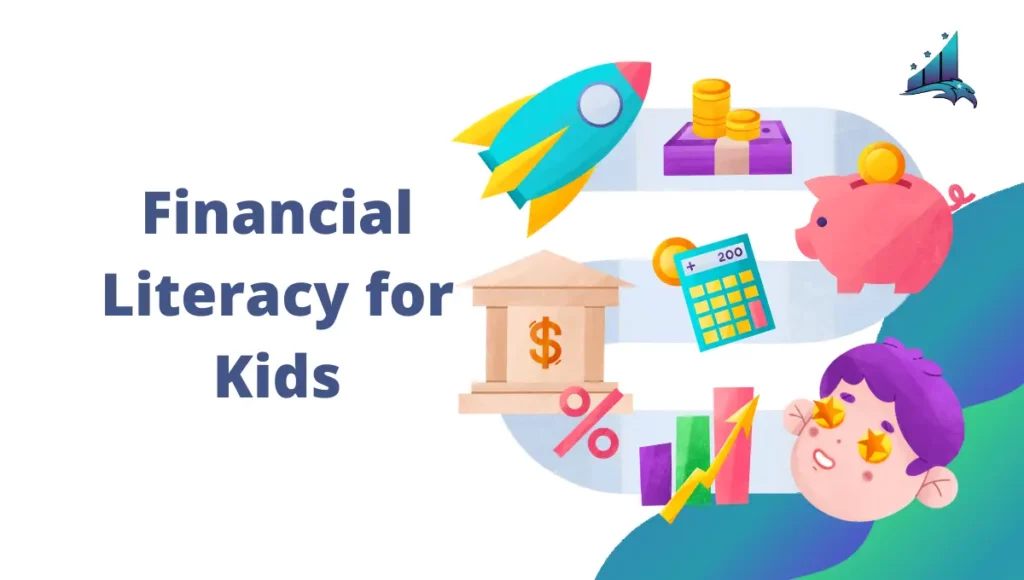Table of Contents
ToggleFinancial Literacy is meant to be an education on financial planning and management. This is equally important as graduation.
Why we plan to make our children a graduate. To get a job right. The ultimate result is income (Finance).
Total humanity requires income, for which education has become an investment nowadays. Hence, financial education is as important to handle and leverage.
Why is Financial Literacy for Kids Important?
· We must have seen many families where their father works hard to make his generation upper middle class or rich.
· Only a few families tend to continue the legacy of being rich.
· Others spend all the investment and savings that their ancestors collected.
· This is only because of the failure of the parents to not educate them on our financial planning or management.
· Let us now dive into the course of how we can educate our children with a few stages depending on the age group.
- Stage I – Early Childhood (Age 4–8)
- Stage II – Middle Childhood (Age 8–12)
- Stage III – Adolescence (Age 12–18)
- Stage IV – Adults (Age 18–25)
· Let us see what should be done in the course of teaching with these stages.
Stage I – Early Kids Stage (Age 4–8):
· This stage is more important as their brain development and habits develop. As parents, we have to show them good habits.
· Children will copy what we do. When we get up early in the morning and take a book. Our child will be doing the same in the future.
· If we go towards television or social media, our children do the same.
· During this period, make our children save money in a penny bank or child bank account. So they don’t withdraw their savings.
· Provide them with some money at the beginning of every week and make them cultivate a savings habit. This will give our children the awareness and benefits of savings.
· Make our children think about saving more than spending. These habits cannot be seen in our children until we have those habits.
Stage II – Mid Childhood (Age 8–12):
· This stage is the second stepping zone. This gives a second chance to parents who missed teaching their children about financial literacy.
· In this age group, children closely watch us. Our habits and our activities will be seen in our childhood development.
· Educate our children on how to generate income. Job is not the only way for income
· Teach them highly on how to generate passive incomes and lead their focus towards.
· Teach them about investing, not just savings. Lessons on savings should be quit as stage I ends. This stage should know the various ways of investing.
· Don’t teach them only the traditional way of savings like bank savings, RD, FD, LIC policies, etc.
· They should have an initial idea of investment, interest rate, and the benefit of long-term investment.
· In this age group, they have to be in the mindset of investors.
Stage III – Adolescence (Age 12–18):
· The most important stage of everyone’s life.
· At this age, there is a much-proven track record of people who started investing. Few people even earn $660,000 per year.
· At this age period, they should have entered the equity market. It may be an index fund, ETF, or direct stocks. They will have a long runway.
· Teach them the power of compounding. We suggest a book on “The Compounding Effect” by Darren Hardy.
· Also, at this age, they should have a DEMAT account, and as a parent, don’t provide birthday gifts. Buy some stocks for them.
· Another better way of teaching financial literacy to children is to provide them with the annual school fees at the start of the academic year.
· Let them manage the money by paying fees and keeping the other amount in the bank. We can provide some interest rates for our children as a bonus at the end of the year for the amount they have as a balance.
· This will reduce their instant gratification and increase their interest in investments.
· Make them away from television and advertisement; this will make them investor-minded humans in the future.
· Teach them about “Delayed Gratification”. Teach them about “Needs, Wants, and Savings.”
Teach them to avoid emotional spending, and stay away from offers.
Stage IV – Adults (Age 18–24):
· As a parent, when we have made a strong foundation over the previous three stages. This will be a relaxing stage.
· Our children will have as much knowledge as we do. They will have practical experience too in investing.
· They will be good at picking a company to invest in, seeing its business model.
· Never pressure our children for a job; create a platform to make passive income. But, they have to start from starch, not getting initial interest from us.
· Teach and guide them on how to invest in books, investing in developing their skills.
· Educate them on asset allocation and portfolio management.
· Guide them on writing their book, e-books, blogging, etc.
When you guide your kids with good financial literacy, we can be damn assured they will also teach their children. This results in our generation being on the safer side. To educate them, we should know everything about financial literacy.
Conclusion
· Follow the guidance of all four stages. Deploy in our children’s life.
· Perfect education on financial literacy will make our generation to be rich.
· Please comment on your child’s age. Have you started the lessons on financial management with your children?
At this time, I would like to thank my mother (A. Maria Jeya), who taught me the value of 1 rupee. The reason behind my financial literacy.
